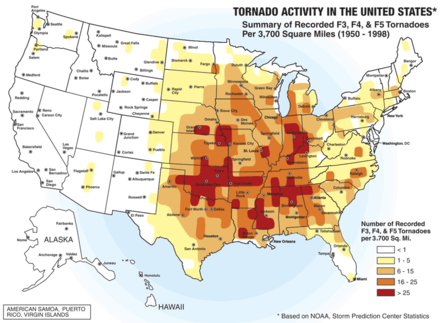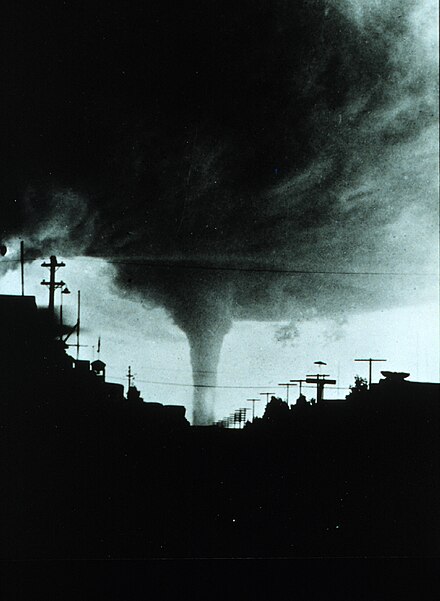For the place in West Virginia, see Tornado (West Virginia). In some parts of the world, especially in the United States, tornadoes – sometimes called "twisters" – can pose a danger to travelers.
Understand

A tornado is a spinning column of very low-pressure air, which sucks the surrounding air inward and upward. They generate high winds (often 100-200 miles/hour) and can lift heavy objects into the air, carrying them as the tornado moves. They begin as funnels descending from storm clouds, and become "tornadoes" when they touch the ground. Unlike hurricanes, tornadoes develop very quickly, giving little advance warning that one is coming (minutes at most), but they are also very short-lived, likewise lasting only a matter of minutes each. They frequently occur in clusters, with several tornadoes striking an area around the same time.
Compared to a cyclone (hurricane or typhoon), a tornado is much more concentrated. While cyclones are generally at least dozens of miles across and sometimes hundreds, it is quite rare for a tornado to be even one mile wide.
About 1,000 tornadoes are reported each year in the US, but only a small percentage of those touch down and strike buildings. Also, less than 30% of the tornadoes that occur are significantly powerful (EF2+). Most deaths occur to occupants of mobile homes and cars. Tornadoes can occur any time during the year, but they are most frequent in the spring and early summer, in thunderstorm weather. Keep in mind that as a short-term visitor, the odds of you being in the wrong place at the wrong time to face a tornado are quite small, regardless of when and where you travel. But it's good to be prepared.

The area where tornadoes occur most frequently is dubbed "Tornado Alley". Tornado Alley is in the Great Plains region of the United States. It includes north Texas, Oklahoma, Kansas, Nebraska, and eastern South Dakota. But tornadoes can develop anywhere cool dry air and warm moist air intermix, and powerful tornadoes happen fairly often in the Midwest, the South, and to a lesser extent the Mid-Atlantic. The western side of the US experiences tornadoes too but with far less activity than the eastern half of the US. The area with the second highest likelihood of tornadoes occurring is the South America Tornado Corridor, an area covers the south and part of southeast of Brazil, Uruguay, central and northern Argentina and southern Paraguay. Tornados can happen in other countries as well. In fact, the Netherlands has the highest rate of tornadoes for its small land area. Canada experiences tornadoes too but less extreme and frequent than the States. Most of them occur in southern Alberta, Saskatchewan, Manitoba and sometimes southern Ontario and Quebec. Tornadoes do not occur in arctic areas, due to cold weather year round.
Prepare
Despite their rapid development, tornadoes do not strike entirely without warning. Meteorologists can identify conditions right for tornadoes to develop, and the U.S. National Weather Service issues two main alerts for them (with confusingly similar-sounding names):
- Tornado Watch - This indicates that conditions are right for tornadoes, but none has been observed. Monitor conditions and listen for further alerts.
- Tornado Warning - A tornado or funnel cloud (a precursor to a tornado's touching down) has been spotted or is indicated by radar. This is when tornado sirens may begin. Seek shelter immediately. When a powerful tornado is headed for a densely populated area, the NWS issues a Tornado Emergency to stress the severity.
At latest when you get a tornado watch alert, check where to take shelter. In tornado areas there are often dedicated safety rooms in or near rural homes and mobile home parks, and when there is none, you should make a plan for the safest place available.
Listen

Some local areas have tornado sirens and lights, especially in Tornado Alley and other regions where tornadoes are a seasonal occurrence. If you hear what sounds like an air raid siren, this is probably a tornado siren sounding, and you should seek shelter immediately. Many communities periodically test these systems at a set time, such as at exactly noon on a weekday of the first week of each month, so check the time and the skies (tornadoes do not develop in sunny weather) before panicking. (Most communities will skip these tests if the weather is stormy, to avoid causing undue alarm.)
Heavy rain and hail can hide a tornado from view. This is especially likely in the more humid regions of the southern and eastern US. Tornadoes will also be very difficult to see at nighttime, unless backlit by frequent lightning. The roar of a tornado (similar to a freight train or a jet aircraft taking off) may be the only sign that one is approaching.
Watch
There are some specific signs that a tornado is developing or likely:
- Debris - If you see a cloud of debris being swept into the air in the distance, that could mark the position of a tornado even if you don't see the funnel cloud.
- Green Clouds - Green clouds are normally seen when there is a large amount of ice in the clouds. This is an indication of hail and could be a warning that a tornado is likely.
- Hail - Hail will sometimes occur. The larger the hail the more likely that there may be a tornado associated with the storm.
- Rotation - If you see rotation in the clouds (not just a swirl of wind near ground level, which is an entirely different phenomenon), that may indicate the presence of a tornado or the possibility of a tornado developing.
Day or night, A loud continuous roar or rumble which doesn't fade in a few seconds like thunder or a train could indicate a tornado.
Stay safe
Do not take shelter under a bridge, most notably an underpass or overpass! The winds from the tornado tend to be stronger under the bridge, and flying debris funneled under the bridge can injure or kill.
In the event of a tornado, please forget that you're a camera-wielding tourist. Don't try to snap photos to document your big adventure. Don't try to retrieve your luggage. Just get yourself to safety immediately.
Get in!
The safest place to be is in a storm shelter or safe room built specifically for tornado safety. In tornado areas these are found frequently in or near rural homes and mobile home parks. The most important thing is not to panic. Stay calm and find the safest area you can get to quickly.
House
If you are in a house, get away from the windows (which will probably shatter) and go to the lowest floor. If there is a basement, go there and get under something such as a bench or table. If there is no basement, go to a center room with no windows, such as a closet or bathroom. If in the bathroom, lie down in the tub. Crouch down and if you have some padding such as a mattress to protect you from flying or falling debris, put that over you. Do not waste time by trying to save property.
Tall building
Go to the lowest floor or center of the building away from windows and close to an interior wall. Crouch down and cover your head. Do not get in the elevator; you'll be trapped if the electricity goes out, and there's always a chance that the lift mechanism will give out if the roof is damaged. If you're not too high, use internal stairways to reach the ground floor or basement. Stairwells are probably one of the safer places to seek shelter in such circumstances anyway (i.e. no windows, sturdy construction).
Get out!

The least safe place to be is inside something the tornado can pick up; you're actually better off outside.
Mobile home
If you are in a mobile home and there's a tornado warning, you should seek out the nearest storm shelter or protected building. People morbidly joke that mobile homes and trailers must somehow attract tornadoes because they are so often shown on TV as twister disaster areas; the serious truth is that their vulnerability is why they make for the most sensational news clips. Studies have shown that a mobile home is the worst place you can be during a tornado; the broad sides of the structure are like a sail in the wind, and there's nothing to hold them in place. It may sound counterintuitive, but you should leave the mobile home and get in a ditch, culvert, or drain pipe, low to the ground. If you are staying in a trailer park, ask management if there is a tornado shelter close by – in advance. These may be cellars or sturdy buildings.
Car
If you are in your automobile and you see a tornado coming, don't try to out-run it; tornadoes can easily outrun a car driving into a 100-mph headwind. Your safest option is to leave the car and get in a sturdy building. If that is not available, get out of the car and get in a low area such as a culvert, drain pipe or ditch. If you are staying in your car, attempt to drive at right angles to the tornado to get out of its path. If the tornado does not appear to be moving left or right, chances are it is coming straight for you. A car is probably safer than a mobile home (less wind-catching surface to drag it into the air), but it's still safer to get out and hunker down low. The best option is to find a ditch to lie flat in, and cover up.
After a tornado
Watch out for sharp objects and downed power lines. Do not stand in water where there are power lines down. Stay out of heavily damaged houses and buildings as there may be a danger of collapse. Lighters and matches should not be used as there may be a danger of gas leaks. Remain calm and wait for instructions from local emergency personnel.
See also
Related Wikipedia article: Tornado